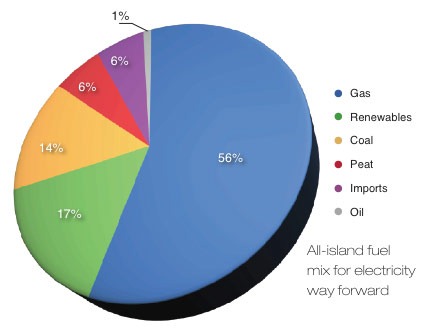EirGrid Annual Renewable Report: summary and trends
 Wind capacity must be more than trebled to meet Northern Ireland’s 2020 target. The EirGrid Annual Renewable Report sets out what is needed for the future and also recalls the history of Irish electricity.
Wind capacity must be more than trebled to meet Northern Ireland’s 2020 target. The EirGrid Annual Renewable Report sets out what is needed for the future and also recalls the history of Irish electricity.
Northern Ireland currently is on a “clear path” to meet its target of 20 per cent of electricity from renewables by 2015, according to EirGrid’s Annual Renewable Report. However, reaching 40 per cent by 2020 will involve more than trebling the province’s current wind capacity. Twelve per cent of electricity demand in 2012 came from renewables. Wind capacity stood at 484MW in September but needs to be nearly 1,300 MW in eight years’ time.
Renewable energy met 17 per cent of all-island electricity demand in 2011, up from 5 per cent in 2005. Wind power has, at times, met 38 per cent of daily demand, rising at 50 per cent at shorter intervals. Renewables displaced around €300 million in natural gas imports: the equivalent of the energy needs of 350,000 homes in the South.
The whole island had 2,484 MW of renewable generation as of September 2012. The breakdown of total installed capacity in the Republic was 1,695MW for wind, 237MW for hydro-electricity and 68MW for other renewable sources.
An expected installed capacity of 4,800-5,300MW across the island by 2020 would give the island one of the highest penetrations of renewable generation in the world. EirGrid was also seeking to identify and solve the operational challenges associated with ocean energy, biomass and waste-to-energy technologies. A memorandum of understanding between the UK and Irish governments (on renewable exports from Ireland) is also anticipated by the end of 2012.
The Irish Government published an updated renewable energy strategy in May 2012, followed in July by an integrated marine plan and a policy statement on the strategic importance of transmission and other energy infrastructure. A revised energy policy framework is due to be published within the next year, updating the current version which dates from 2007. The EU Infrastructure Package is also unlikely to be finalised during Ireland’s Presidency of the Council of the European Union (January-June 2013).
Westminster’s Energy Bill should result in feed-in tariffs with contracts for difference being implemented in Great Britain in 2014 and Northern Ireland in 2016. The carbon price floor will also result in Northern Ireland’s conventional generators paying more tax on their fuel if the price of carbon is below £16 per tonne in 2013; this will rise to £30 per tonne by 2020.
EirGrid’s report was published before the UK Government’s final agreement on the Energy Bill, announced in 22 November. The Coalition Government announced a cap of £7.6 billion (at current prices and £9.8 billion in 2020) on the levy on consumers to support renewables and new nuclear power, and a delay on finalising the 2030 decarbonisation target until 2016, after the next general election.
To mark the 85th anniversary of the construction of the hydro-electricity plant at Ardnacrusha, the report also includes a timely history of Irish electricity. In a rare public appearance, to commemorate the occasion in July, former Taoiseach Liam Cosgrave praised the “foresight, imagination and enterprise” of the Irish Free State Government at the time, which had been led by his father WT Cosgrave. The decision to proceed with the electrification of Ireland, the report noted, “set the country on a path of economic and social development that has had a profound impact on the lives of generations of Irish citizens.”






